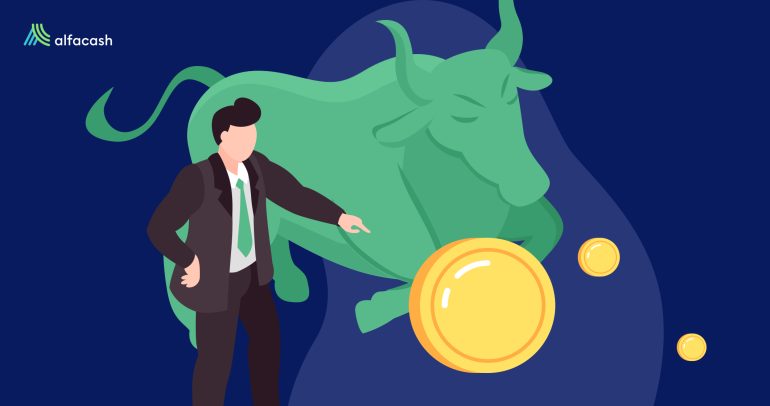It may sound like a complicated term but isn’t a big deal once you get it and put it into practice, even. To make it quick: Proof of StakeProof of Stake (PoS) was created as an alternative to Proof of Work (POW), supporting cheaper and faster transactions. It... More (PoS) is a type of digital system (algorithm) to achieve consensus in a blockchainBlockchain is a type of database storing an immutable set of data, verifiable to anyone with access to it —through..., which means verify transactions and mint new coins. And yes, it can be a way of passive income as well, for anybody with enough funds at hand.
So… is this something like mining cryptocurrencyA digital currency running on a blockchain and built with cryptography. Contrary to central-bank issued currency, cryptocurrency issuance rules are... More? Well, sort of. It’s basically an alternative for the traditional Proof of WorkProof of Work (PoW) lets one party proof the execution of an algorithm to another party. In the Bitcoin PoW... More (PoW) cryptocurrency mining, which is used by coins like BitcoinBitcoin is the first decentralized digital currency. It was created in 2009, by an anonymous founder or group of founders... More (BTCAn abbreviation for Bitcoin.). Let’s remember that a bit.
PoW is another algorithm, and by “algorithm” we mean a set of steps and methods that are built —with math— to achieve a specific result or solve a problem. That’s exactly what the PoW does: develop a difficult math problem or riddle that the miner’s equipment must solve in order to verify virtual transactions. They’ll win then some cryptocurrencies as a reward for their services.

This minerMiners secure some blockchain networks by ordering crypto transactions into blocks and verifying the blocks of other miners. For this... More will need powerful hardware, a certain amount of technical knowledge, and a lot of electricity to succeed in their task. Now, in PoS systems (and coins) the figure of the “miner” is replaced by the “validator”. This validator, which can be anybody who wants to, won’t need much of that. Instead, what they’ll do is locking inside a special walletA crypto wallet is a user-friendly software or hardware used to manage private keys. There are software wallets for desktop... More a certain amount of native tokens that they previously acquired.
So, they’ll obtain the right to verify transactions and mint new coins, if necessary, and almost automatically. And they’ll be rewarded for it, as a passive income. That has its disadvantages, though.
What’s wrong with PoS, then?
The short answer for this is the security provided to the network. Let’s pause a bit here to talk about forks. You know, most cryptocurrencies are wild and free of any copyright, open-source and decentralized. That means anybody with the knowledge can copy and paste their own version of the same cryptocurrency: that’s a fork, because they can split the network to take it into another direction.
To put it more clear, Bitcoin Cash (BCH) is, for example, a fork of Bitcoin (BTC). They have the same history till 2017, when BCH split into another direction and with new functionalities. But hey, they’re both works with PoW, not with PoS. That means the miners should’ve decided then between the two of them. Their computational power, their hard efforts, can’t be shared with two chains, because that would be double-spending the same money.

That’s actually a risk with PoS systems. With PoW doesn’t make sense to create endless forks, but in PoS they can be profitable for the cheaters. So, the user could jump between the original chain where they already spent the money and the new chain where they didn’t, for example. There’s no “work” to verify the transactions here, only stakeholders.
The developers are working on this possible issue. Punishments for bad behavior have been proposed, like slashing or confiscating the stakes of the cheaters. That’s a work in progress, though. And PoW systems have, as well, some drawbacks.
So, what’s wrong with PoW?
Probably the main issue that may arise legit concerns about this system is the environmental factor. PoW blockchains are mostly strong and secure, but the cost is the energy (electricity) spent by the hardware to solve the math riddles (the work).
According to the Cambridge Center for Alternative Finance (CCAF), Bitcoin (for example) has an estimated annual energy consumption of around 12.65 TWh. For perspective, that’s more than countries like Finland, Switzerland, and Portugal.
Considering that every 1 KWh produces approximately 1 pound of carbon dioxide (CO2) liberated to the atmosphere (and polluting it), that’d mean around 6,4 Mt (millions of tons) CO2 as a result every year. Of course, this is more like a small figure, comparing it with other activities, industries, and countries.

The banking industry produces around 319,5 Mt CO2 annually. The gold mining produces 69,4 Mt CO2, United States 1,951 Mt CO2, and China 2,782 Mt CO2. Beyond this, as indicated too by the CCAF, Bitcoin takes barely 0.49% of the total energy consumption.
Additionally, a study made by the firm CoinShares revealed that the crypto-miners use to establish themselves in places where the electricity is cheaper, to make more profits. And cheaper electricity usually means renewable (and non-polluting) energy sources, such as hydroelectric. So, this matter is still under discussion.
PoS coins as a passive income
Putting aside which system is better (an answer isn’t established yet, anyway), something sure is people can make passive earnings just by holding PoS coins in their wallets. The more you have, and the more time you have them locked (unused), then the more earnings you can get (in that same currency).
You can think of it as something similar to savings accounts, but probably with more interests. And, we should say, with probably more money at stake as well. Becoming a PoS validator doesn’t use to be cheap, precisely. That’s because the main principle behind this system is that their users should be really interested in the wellbeing of the network.

We can use some examples here. Recently, Ethereum released its first PoS system. To become a future validator of it, the users must’ve locked 32 ETH (now around $41.6k) in the wallet destined to it. According to the (experimental) calculator provided by Ethereum Price, this would imply around 8.9% in annual interest earned.
The figures vary in different PoS coins. Dash demands a 1,000 tokens collateral ($105,700) for its PoS validators and offers around 6% yearly interest. On the other hand, in Cosmos (ATOM) there are different levels for staking. The first one doesn’t require any specific amount as a minimum to stake, you can do it easily from wallets like Atomic Wallet, and the calculated profit is 8% yearly. The next level (for official validators) is harder to reach, though. The costs are over $57k.
In conclusion? PoS coins can make a really nice passive income, but not without some nice investment. Anyway, in case you’re interested, here you can find a list of PoS coins to pick. But don’t forget to do your own research (DYOR) first!
Wanna trade BTC, ETH, and other tokens? You can do it safely on Alfacash! And don’t forget we’re talking about this and a lot of other things on our social media.
Twitter * Telegram * Instagram * Youtube *Facebook * Vkontakte








